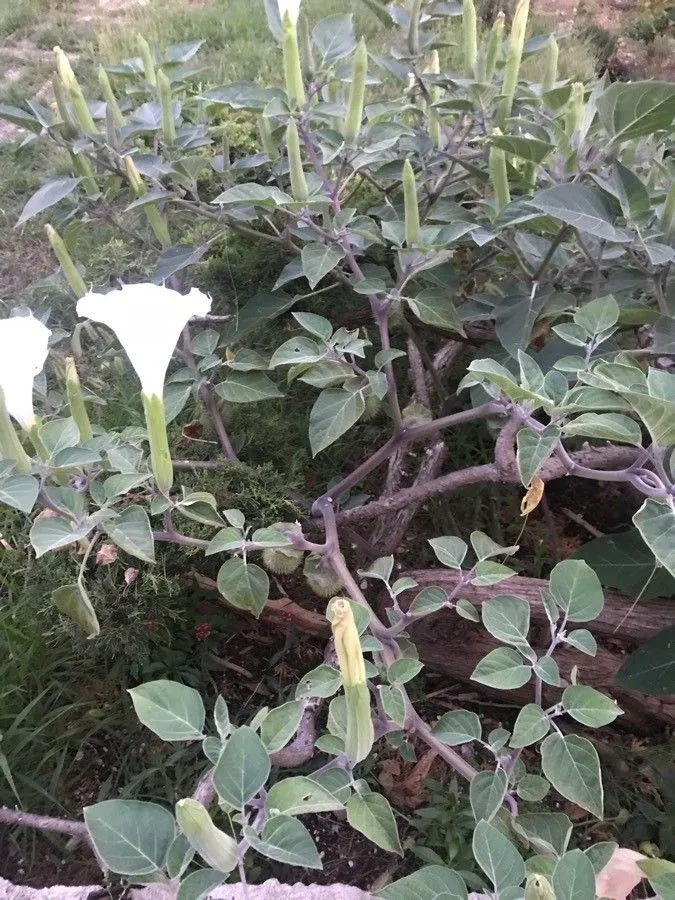
Author: Mill.
Bibliography: Gard. Dict. ed. 8: n.º 5 (1768)
Year: 1768
Status: accepted
Rank: species
Genus: Datura
Vegetable: False
Observations: Arizona to Texas and Mexico
Indian-apple, scientifically known as Datura innoxia, is a plant that belongs to the Solanaceae family. This particular species was described in the Gardener’s Dictionary, eighth edition, as entry number 5, published in 1768 by the botanist Mill. Native to the regions spanning from Arizona to Texas and extending into Mexico, this plant has established its presence in diverse environmental conditions.
Datura innoxia is readily recognized for its strikingly large, trumpet-shaped flowers, which are typically white but can occasionally display tinges of purple. These blossoms open in the evening, releasing a pleasant fragrance that attracts nocturnal pollinators like moths. The plant’s foliage is equally distinctive, with broad, deep-green leaves that have a slightly velvety texture.
One of the notable traits of Indian-apple is its hardiness and ability to thrive in arid climates. This adaptability has allowed it to spread throughout its native range and even beyond, where it often occupies disturbed soils and open fields. Despite its beauty, it is important to exercise caution around this plant, as all parts of Datura innoxia contain toxic alkaloids. Historically, various cultures have both revered and feared its potent properties, using extracts for medicinal purposes under controlled conditions, but also recognizing the dangers of accidental poisoning.
Gardeners and enthusiasts interested in cultivating Indian-apple should handle it with care, ensuring that it is planted in well-drained soil and receives ample sunlight. While it can be a striking addition to gardens, providing aesthetic appeal with its dramatic flowers and lush foliage, the plant’s toxicity should always be taken into account to prevent accidental ingestion by humans or animals.
In summary, Datura innoxia is a remarkable specimen within the Solanaceae family. Its resilience, captivating floral display, and historical significance make it a fascinating subject of study and admiration, though it requires mindful handling and respect for its potent chemical properties.
Dan: centralamerikansk pigæble
Spa: chamisco doble, arbol del cielo, burladora, cacaito, chamico, estramoni, estramonio, figuera infernal borda, flor de la trompeta, herba pudenta, herba talpera, hierba del infierno, hierba hedionda, higuera del diablo, higuera loca, orval, toloache, trompetilla, tártago, túnica de cristo
Heb: datura netuyat-pri, דטורה נטוית פרי
Deu: feinstacheliger stechapfel, feinstachliger stechapfel, garten-stechapfel
Eng: indian-apple, pricklyburr, angel’s trumpet, angel’s-trumpet, desert thornapple, downy thorn-apple, hoary thorn-apple, recurved thorn-apple, sacred datura, thorn-apple, fireweed, joy juice
Fra: stramoine à grandes fleurs, datura innocente, stramoine inoffensive
Ita: stramonio metello
Ara: datura, tatoora
Ces: durman neškodný
Afr: harige stinkblaar
Hun: indián maszlag
Swe: mexikansk spikklubba, amerikansk spikklubba
Ell: tatura, zornes
En: Indian-apple, Pricklyburr, Angel’s trumpet, Angel’s-trumpet, Desert thornapple, Downy thorn-apple, Hoary thorn-apple, Recurved thorn-apple, Sacred datura, Thorn-apple, Fireweed, Joy Juice, Downy Thornapple, Indian Apple, Pricklybur, Toloache, Downy thorn apple
Af: Harige stinkblaar
Ar: Datura, Tatoora
Cs: Durman neškodný
Da: Centralamerikansk pigæble
Fi: Nukkahulluruoho
Fr: Stramoine à grandes fleurs, Datura innocente, Stramoine inoffensive
De: Feinstacheliger Stechapfel, Feinstachliger Stechapfel, Garten-Stechapfel, Teufelstrompete
El: Tatura, Zornes
He: Datura netuyat-pri, דטורה נטוית פרי, דטורה נטויית-פרי
Hi: धतुरा
Hu: Indián maszlag
It: Noce metella, Stramonio metello, Stramonio metelo
Mr: धोतरा
Es: Chamisco doble, Arbol del cielo, Burladora, Cacaito, Chamico, Estramoni, Estramonio, Figuera infernal borda, Flor de la trompeta, Herba pudenta, Herba talpera, Hierba del infierno, Hierba hedionda, Higuera del diablo, Higuera loca, Orval, Toloache, Trompetilla, Tártago, Túnica de Cristo
Sv: Mexikansk spikklubba, Amerikansk spikklubba
Taken Aug 23, 2020 by cha ma (cc-by-sa)
Taken Jul 28, 2019 by Dominique Wernert (cc-by-sa)
Taken Jul 15, 2021 by Manuëlle (cc-by-sa)
Taken Jul 9, 2021 by Carles Carles (cc-by-sa)
Taken Aug 10, 2021 by SASTRE Isern (cc-by-sa)
Taken Jul 9, 2021 by Carles Carles (cc-by-sa)
Taken Nov 19, 2020 by Andrea Georgiades (cc-by-sa)
Taken Jun 24, 2020 by svetlana ogneva (cc-by-sa)
Taken Oct 26, 2022 by Adriaens Tim (cc-by-sa)
Taken Sep 4, 2017 by Remo Cela (cc-by-sa)
Taken Oct 5, 2021 by zonstiges1 (cc-by-sa)
Taken Sep 28, 2021 by Pablo Espinosa (cc-by-sa)
Taken Jul 28, 2019 by Dominique Wernert (cc-by-sa)
Taken Jan 7, 2021 by Aytaç Kurtuba (cc-by-sa)
Taken Jul 9, 2021 by Carles Carles (cc-by-sa)
Taken Oct 6, 2021 by Sabin Poenariu (cc-by-sa)
Taken Aug 12, 2022 by manuseitz (cc-by-sa)
Taken Jul 31, 2022 by Michal Svit (cc-by-sa)
Taken Jul 28, 2019 by Dominique Wernert (cc-by-sa)
Taken Jun 18, 2017 by Yoan MARTIN (cc-by-sa)
Taken Aug 16, 2022 by Martí Salvador (cc-by-sa)
Taken Sep 21, 2022 by Werner Rom (cc-by-sa)
Taken Jun 18, 2021 by Sabin Poenariu (cc-by-sa)
Taken Nov 3, 2021 by Camellia Rusticana (cc-by-sa)
Taken Sep 30, 2020 by Amalia Mei (cc-by-sa)
Taken Oct 15, 2016 by Photoflora – Benoit BOCK (©)
Taken Oct 15, 2014 by Photoflora – Benoit BOCK (©)
Taken Aug 10, 2020 by Nicolas Nioche (cc-by-sa)
Taken Dec 20, 2021 by Espinoza-Zevallos Marco Elías (cc-by-sa)
Taken Oct 13, 2022 by Ivanete Pretinha Andrade (cc-by-sa)
© copyright of the Board of Trustees of the Royal Botanic Gardens, Kew.
© copyright of the Board of Trustees of the Royal Botanic Gardens, Kew.
© copyright of the Board of Trustees of the Royal Botanic Gardens, Kew.
Ph maximum: 8.0
Ph minimum: 7.5
Light: 7
Atmospheric humidity: 5
Soil nutriments: 8
Family: Myrtaceae Author: (F.Muell.) K.D.Hill & L.A.S.Johnson Bibliography: Telopea 6: 402 (1995) Year: 1995 Status:…
Family: Rubiaceae Author: Pierre ex A.Froehner Bibliography: Notizbl. Bot. Gart. Berlin-Dahlem 1: 237 (1897) Year:…
Family: Sapindaceae Author: Koidz. Bibliography: J. Coll. Sci. Imp. Univ. Tokyo 32(1): 38 (1911) Year:…
Family: Asteraceae Author: A.Gray Bibliography: Pacif. Railr. Rep.: 107 (1857) Year: 1857 Status: accepted Rank:…
Family: Fabaceae Author: Medik. Bibliography: Vorles. Churpfälz. Phys.-Ökon. Ges. 2: 398 (1787) Year: 1787 Status:…
Family: Aspleniaceae Author: (Cav.) Alston Bibliography: Bull. Misc. Inform. Kew 1932: 309 (1932) Year: 1932…